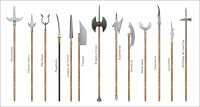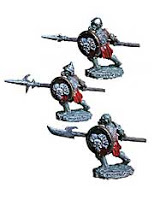 I love the vast array of different polearms in AD&D. That Unearthed Arcana has an entire appendix devoted to them only makes it all the better in my opinion.
I love the vast array of different polearms in AD&D. That Unearthed Arcana has an entire appendix devoted to them only makes it all the better in my opinion.
A lot of folks make great sport of the huge number of different polearm options in AD&D. They are seen as an expression of Gary Gygax’s “polearm fetish”, and are usually completely ignored by both players and DMs alike. But I think this is a huge mistake, and the first time the DM correctly uses polearms in one of his dungeons, the players will be forced to re-evaluate their choice of weapon proficiencies, as well.
To be fair, the variety of polearm options only comes into fullest blossom when three rules are used that, from what I gather, usually are ignored; weapon speed factor, space required, and the dreaded weapons vs. armor class table. Pretty much all of page 38 of the original PHB. (Yes, I am aware that Gygax himself didn’t use two of those factors in his own combats, but bear with me.) I happen to use all (when applicable), and have found that they really don’t make combats go appreciably slower, once players are used to including another adjustment to their “to hit” rolls.
How I Do Initiative
At this point, I should point out that I houserule initiative in a way that makes the weapon speed factor a piece of cake. Everybody rolls a d10, adds their dexterity bonus (if any) and adds their weapon speed factor (or the casting time of their spell, in segments). I start counting out loud. 1… 2… 3… 4… when I hit someone’s number, they say “I go now” and they proceed to tell me what their character does, roll “to hit”, etc. It works really well and it at least approximates the effect of using a slow and clumsy weapon. Monsters using natural weapons like fangs or claws have an assumed speed factor of zero.
The Space Required column on that table (p. 38 of the original PHB) is key to using pole-arms and other weapons in a dungeon environment. Savvy humanoids will, of course, be used to their lairs. Those 10′ corridors are that wide, and twisty-turny, for a reason. Remember the weapons types in the Monster Manual? How most of them include a large percentage of polearms? That isn’t a mistake.
You can, for instance, pack five guisarme-wielding hobgoblins in a 10′ corridor, compared to 2 humans with broadswords. Same damage as a broadsword, but it’s 8′ long and the second and third ranks can attack, so you have to go through 5 attacks just to even get a *shot* at one of the hobgoblins in the hallway (and the way I would work it, due to the reach of the weapons, the hobgoblins automatically get initiative if the PCs decide to attack). The hobgoblins just multiplied their effective attack strength by a factor of two and a half. Working in unison, they’re as effective as a 5-HD monster.
And those invincible fighters with 400 g.p. burning a hole in their small belt pouch? Oh, big man with your plate mail and shield. AC 2. Invincible. Except when those footman’s picks come out and the orcs get an effective 10% bonus “to hit” because they’re wielding what are essentially can openers. You’ve got a +2 longsword? You’re facing 30 humanoids with the effective equivalent of +2 weapons, “to hit”, at least. And you’re going to automatically yield initiative simply to close to hit.
Still think polearms are silly? They are the perfect dungeon corridor weapon when you’ve got a lot of troops to use them. And outdoors, if those goblins form a square, with sharp pointies facing outwards, the melee problems in a dungeon corridor are the same, just on a larger scale.
Don’t write off the polearms.









One of the problems I have with most fantasy genre role-playing games is, they give you a huge list of weapons to choose from, but rarely tell you what those weapons are good for, or in what situations you would expect to find them. You have weapons (and armor) from different time periods, and different strategic situations, all thrown together with no rhyme nor reason.
Excellent points, Joe. The ranseur's disarm ability has seen some use in my AD&D games.
Good post, and especially applicable to my current ruleset (Tunnels & Trolls) because of its group combat mechanic by which monsters effectively form up like Voltron.
Most of the polearms in the PHB are actually not very good. Gygax wrote it like that intentionally, because he was concerned to reflect authentically his conception of their value. Some polearms are very good, bu the ones that hit hardest typically require a lot of space to use.
Honestly, I am not at all convinced that pole arms make good dungeon weapons, and am pretty sure they were intended for larger scale conflicts.
I’ll be happy to run a special game of CotMA for you sometime, Matthew. 😉
There’s also the question of unit discipline. Hobgoblins have a military cachet so I can see them forming up; other humanoids, maybe not so much. And knowing the dungeon might actually be a detriment, because they know where to run and hide.
Having played mostly paladins and cavaliers, I never was a big fan of polearms back in the day, but over the years I’ve developed an interest in the Swiss Guard, dug Cushara the poleman from Clark Ashton Smith’s “Black Abbott of Puthuum,” and become a fan of Warriors on the History Channel. Next time I play a Fighter, I’m buyin’ myself a polearm.
I like it!
There has always been an arms race, it just moved more slowly in the past. Weapons, armor, and combat techniques evolve to defeat each other over time. I think that the weapons lists in D&D products are so large so as to give the DM a choice of technological advancement level for his campaign. The cross section of weaponry listed covers around two thousand years of real world weapons development. In my own Greyhawk, I cut off technological development in weapons at around AD 1350. Plate-mail is available, but not full articulated plate armor. Not every weapon listed exists or is in use just because it's in the book. I love pole arms, but many of them weren't developed until after the advent of gunpowder weapons and those I exclude.
I’ll be happy to run a special game of CotMA for you sometime, Matthew. 😉
I look forward to it! 😀
Interesting. In my own campaign I simulate weapon reach with polearms, spears and other long weapons which does mean that they player’s use them in combat. Especially low hitpoint fighters, who like to use them to hide behind tougher, high hitpoint characters, but still contribute to the fight. Especially as I now award an immediate, small amount of experience for a killing blow to the character who inflicted it…
Everybody rolls a d10, adds their dexterity bonus (if any) and adds their weapon speed factor (or the casting time of their spell, in segments). I start counting out loud. 1… 2… 3… 4… when I hit someone’s number, they say “I go now”
If I’m understanding you correctly, this is a “lower result goes first” deal. If so, then it reads like you’re penalizing the dexterity bonus. For instance if Al (Dex bonus +1) and Bob (no Dex bonus) both have a weapon with a speed factor of 3 and both roll a 6 on the d10, then Al’s initiative is 10, while Bob’s is 9, so Bob goes first because he has a lower Dex bonus. Or am I misreading?
No, just me being unclear. It’s mathematically subtracted from the initiative roll. I was using the word “added” in the sense of “included”…